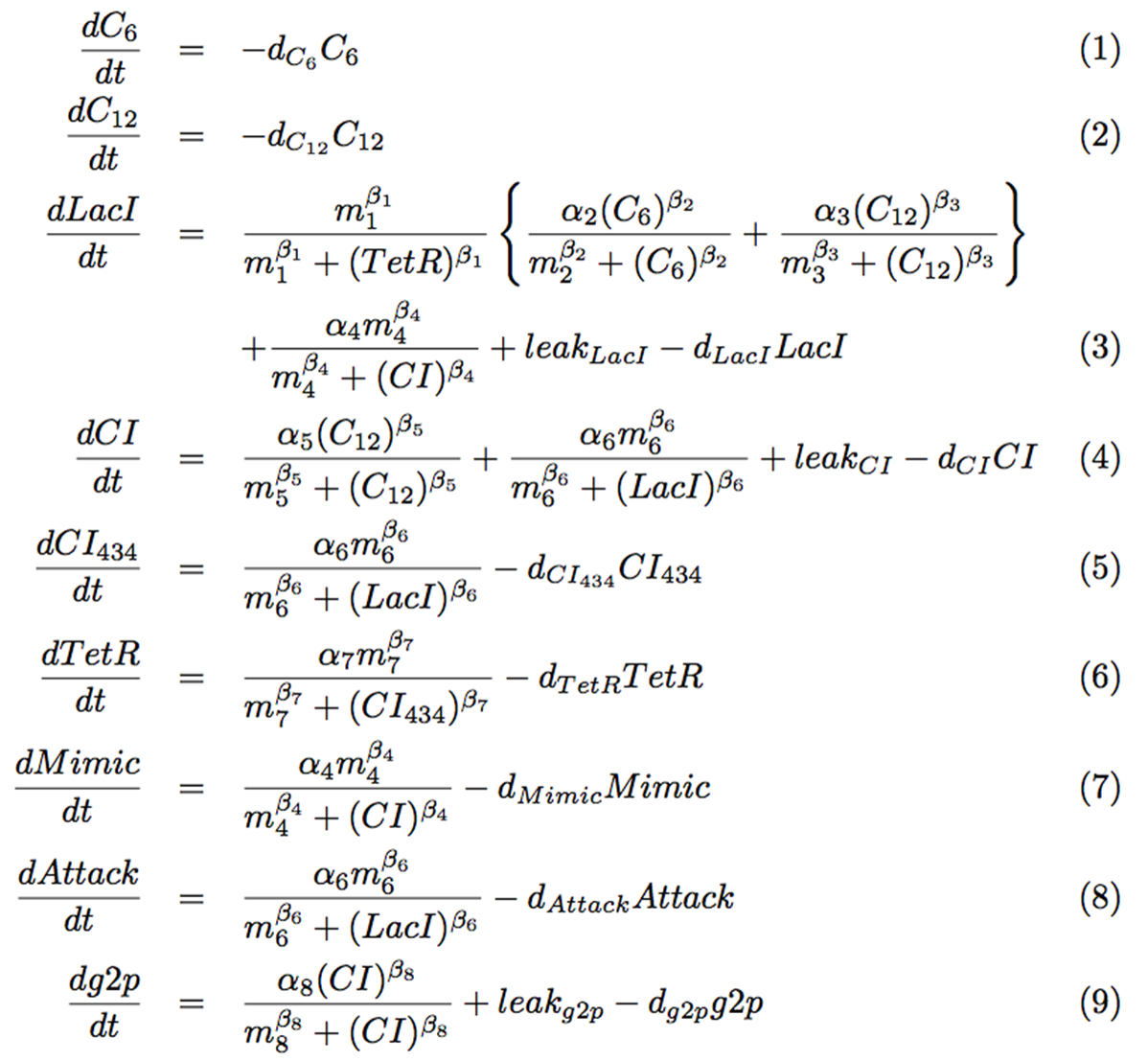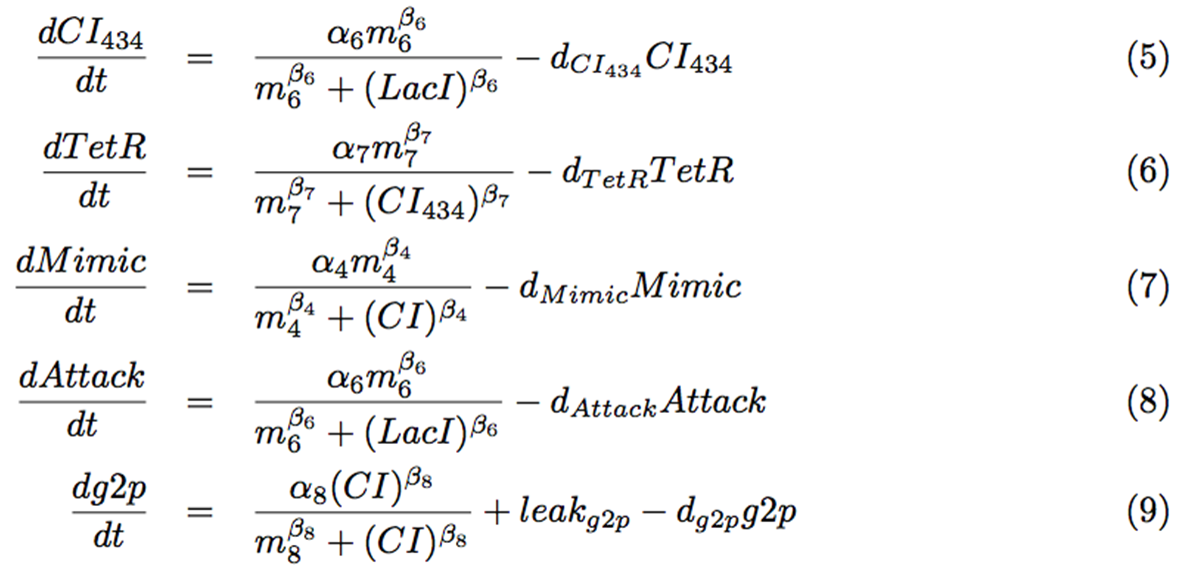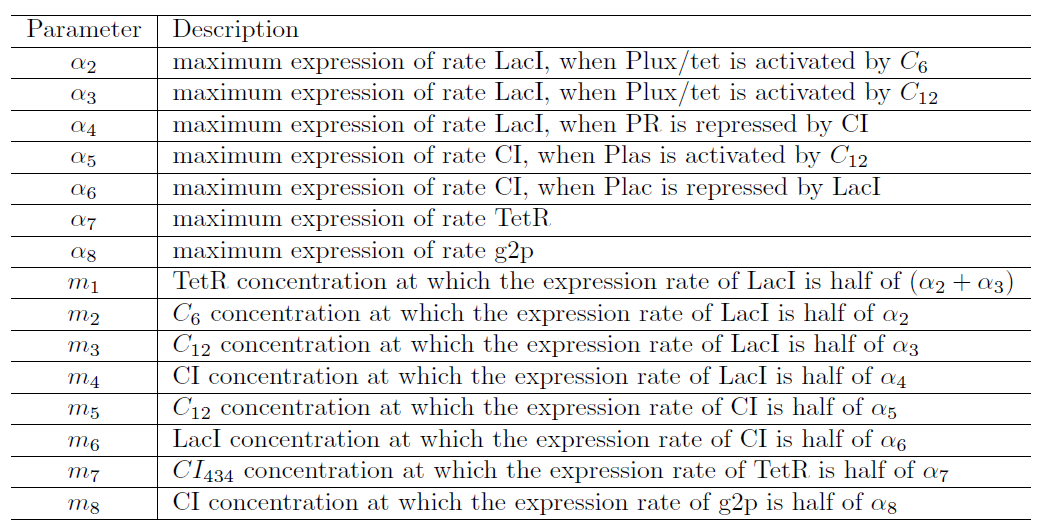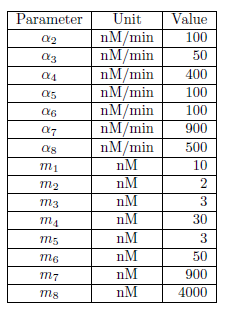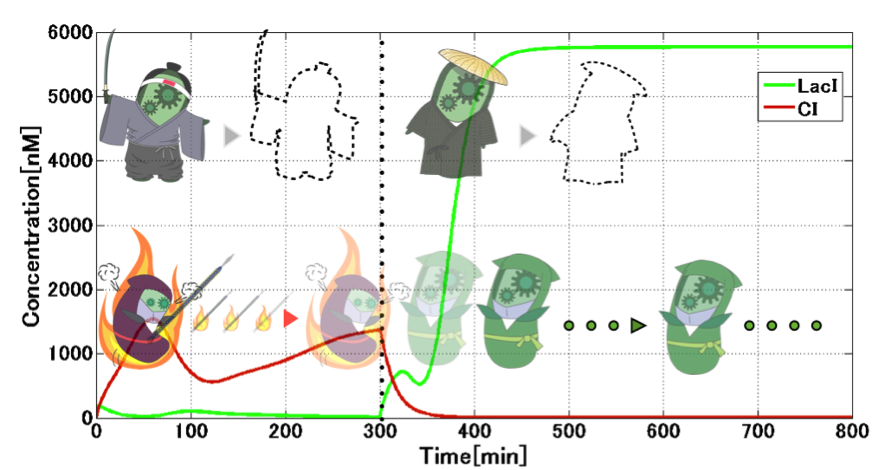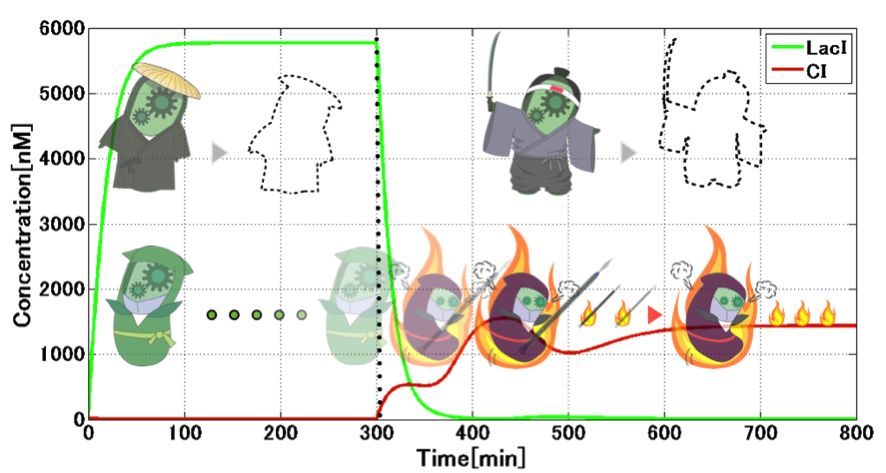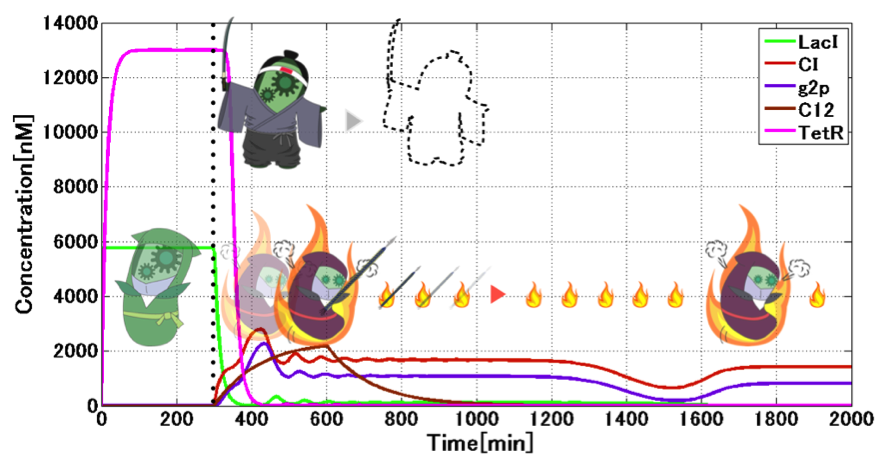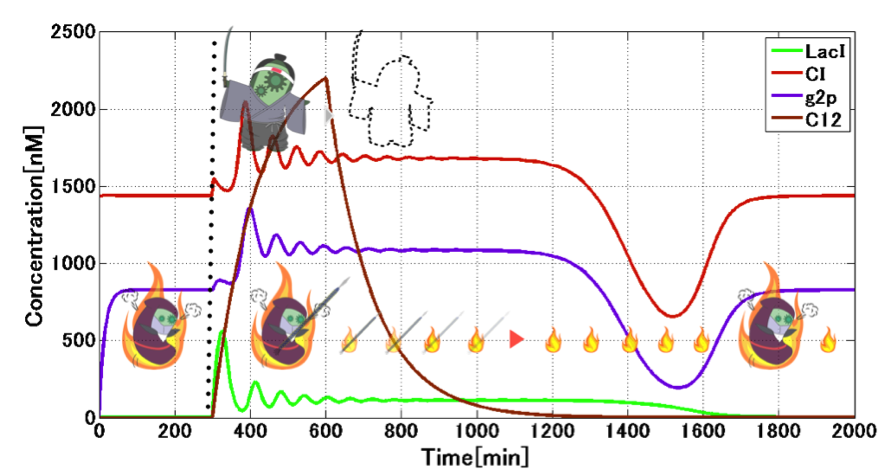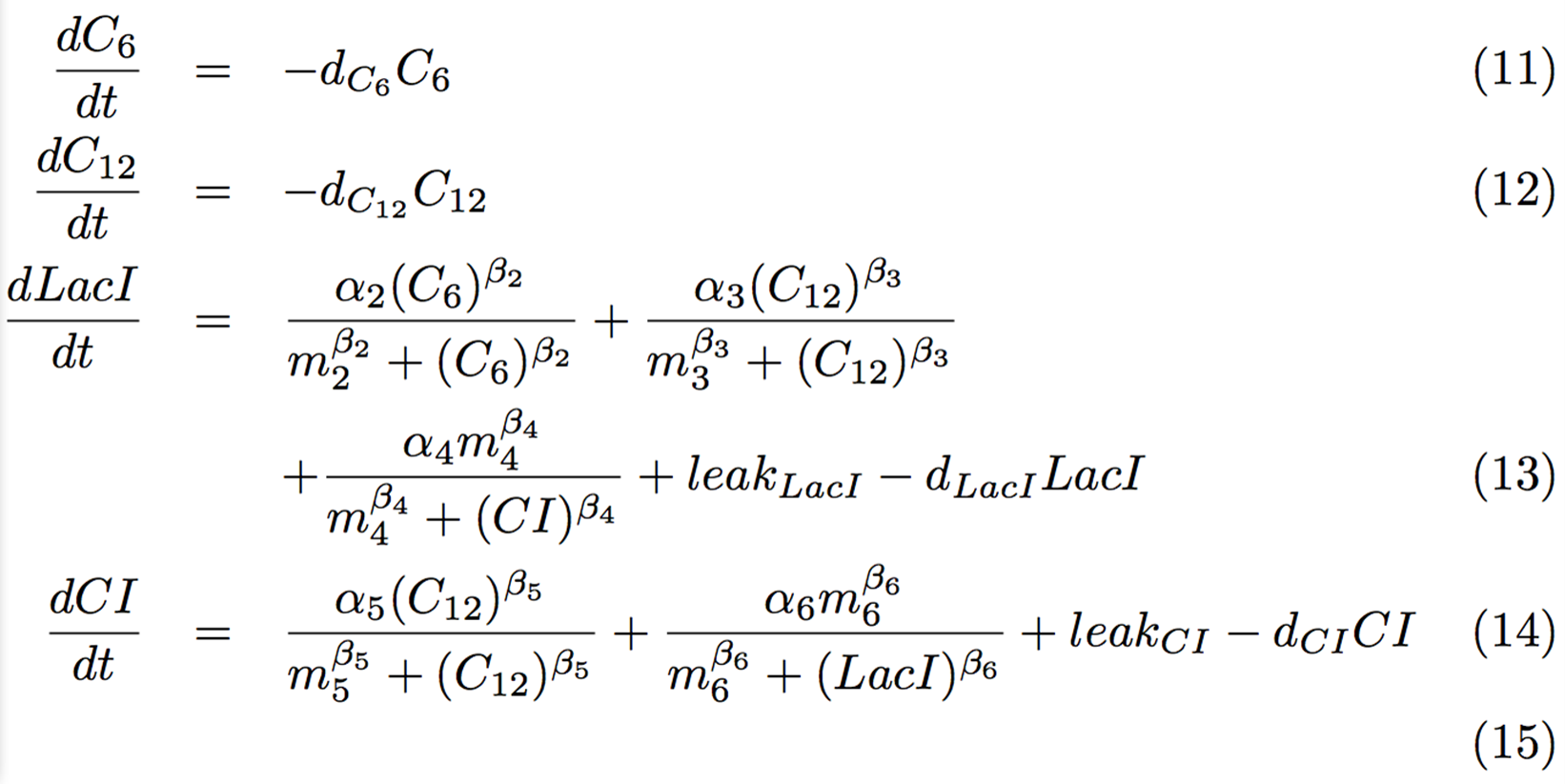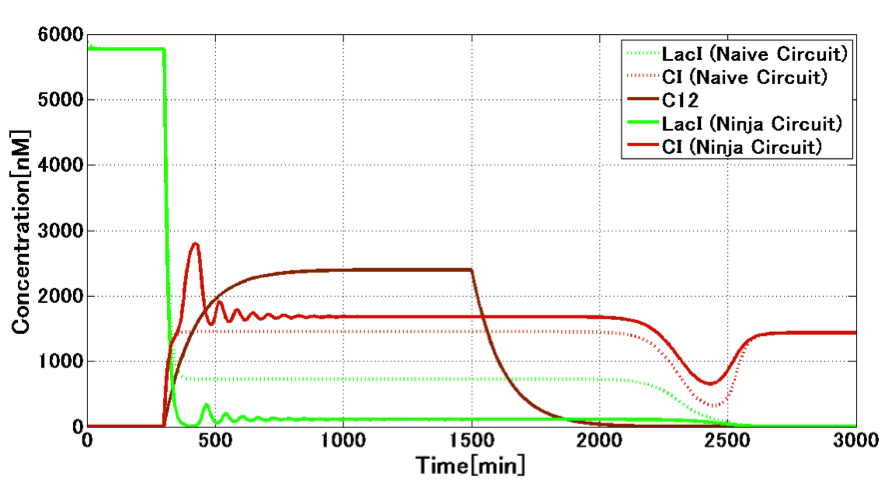Team:Tokyo Tech/Modeling/Crosstalk Circumvention
From 2013.igem.org
| Line 71: | Line 71: | ||
<u> Bistability by the toggle switch in Ninja circuit </u> | <u> Bistability by the toggle switch in Ninja circuit </u> | ||
<h2> | <h2> | ||
| - | <p>We firstly confirmed bistability by toggle switch. In initial state, by pulse addition of 20 | + | <p>We firstly confirmed bistability by toggle switch. In initial state, by pulse addition of 20 nM C12, the CI side get induced and maintained even after decay of C12. After 300 min, with pulse addition of 20 nM C6, the toggle switch starts to switch to LacI “Mimic” state. In addition, the state is maintained after decay of C12. Thus we could get the conclusion that the LacI state stays stable after the switching. |
</p> | </p> | ||
</h2> | </h2> | ||
Revision as of 02:53, 28 September 2013
Crosstalk Circumvention Modeling
Contents |
1. Introduction
In order to achieve Signal-dependent state-change circuit with crosstalk circumvention, we designed ‘’Ninja circuit’’ which is shown in Fig. 4-1-1.
We analyzed the dynamic characteristics of the whole circuit through the modeling of “Ninja” circuit. In addition, we verified how each parameter in the model formula affects the behavior of the circuit.
To understand the difference between our Ninja model circumvention system and the original circuit, which is not able to prevent from signal crosstalk, we compared with two gene circuits on equal terms.
2. Analytical method of dynamic characteristics of the circuit
2-1. Building a mathematical model
On the basis of the Hill equation, we built a mathematical model of thE. ninja circuit. The mathematical model which was used this time was as below. Value for each parameter will be discussed on Chapter 2.3.
We will divide these equations into several groups to explain the mathematical model.
The first group describes change of the signaling molecules (Fig. 4-1-3). At this time, because of the constant expression of LasR and LuxR, only degradation of C6 and C12 are considered. They are added as input in a pulse manner in this section.
The second, in Fig. 4-1-4, is differential equations of LacI. Since we use tet promoter (repressed by TetR), the first term shows the suppression of TetR. Although hybrid promoters which express LacI are activated by C6, we have to consider the influence of the crosstalk, which is represented as addition. Because our wet experiments shows that the expression level by C12 input, which cause cross talk via LasR activation, is about half of that by C6 input, we set a3 value as half of a2 value. About equation (3), not only from the hybrid promoter, LacI is also expressed from one side of the toggle switch. For this expression, we added a Hill equation to show suppression by CI. In the end we add expression amount of the leak, then minus the decomposition item of LacI.
As the third, CI is expressed not only from las promoter, but also from one side of the toggle switch. As a result, we add a Hill equation to show suppression by LacI.
Finally, we derived those following equations based on the circuit as well.
2-2. Description of the parameters
Each parameter is defined as the following table.
2-3. Parameter optimization and simulation
We carried out the simulation of this time by using MatLab. Since the amount of the parameters of the differential equation is very large, we tried to minimize the amount of the evaluation function. (Fig. 4-1-7)
At time point 0, we add C12. C6 then is added 300 min. after induction of the GFP side in toggle switch. If the absolute value of the difference between the integral value of the expression level of RFP and GFP becomes smaller, we could get the conclusion that toggle switch has high performance. The parameters we are about to explore are a4, a5, and a6. a4 and a5 are maximum expression amounts of LacI and CI in bistable state. a6 and a7 are expression amounts of CI434 and TetR as in prevention of crosstalk.
As a result of exploring the a4, a5, a6, and a7 to minimize the evaluation function in equation (10), we found out that it would be the best selection if we take the parameters as follows (Fig. 4-1-9).
2-4. Simulation result and parametric evaluation
Bistability by the toggle switch in Ninja circuit
We firstly confirmed bistability by toggle switch. In initial state, by pulse addition of 20 nM C12, the CI side get induced and maintained even after decay of C12. After 300 min, with pulse addition of 20 nM C6, the toggle switch starts to switch to LacI “Mimic” state. In addition, the state is maintained after decay of C12. Thus we could get the conclusion that the LacI state stays stable after the switching.
Then, we confirmed the performance of the other side of the toggle switch. First, 20 nm C6 was added in a pulse manner, then after 300 min. C12 was added in a pulse manner. From following graph (Fig. 4-1-11), in combination with Fig. 4-1-10, we could get the conclusion that the toggle switch shows bistability as we thought.
Crosstalk circumvention by TetR
After we confirmed the bistability by the toggle switch, we analyzed the switching dynamics.
From the following analysis, we modified equations (1) and (2) to describe presence of either E. samurai or E. civilian. Each of them accumulates a signaling molecule during its presence.
Firstly, we consider the situation that when E. civilian comes to Attack state. Fig. 4-1-12 shows the switching from Attack state to civilian state which is influenced by C6 coming from E. civilian. We can know from this simulation result that when E. civilian comes on the time of 300 min., CI Attack state will switch to LacI civilian state.
During the switching from the Attack state to the Mimic state, the absence of TetR allows activation of lux/tet hybrid promoter. Repression of TetR production, by CI434, is indeed important in the circuit. During the Mimic state, TetR accumulates to plateau level. This presence of TetR is important to prevent crosstalk, in the next figure (Fig. 4-1-13).
Secondly, we consider the situation that when E. samurai comes to the Mimic state. When switching occurs from Mimic state to Attack state, CI is expressed. Note that LacI expression from the lux/tet hybrid promoter is prohibited, due to the presence of TetR, even in the presence of C12-LasR complex which can bind to the hybrid promoter for its activation. Abundant presence of C12 expressed from E. samurai causes CI overexpression, which stimulates expression of g2p required for the programmed phage release. Though degradation of TetR during the presence E. samurai causes LacI expression from the hybrid promoter, CI expression from las promoter overcomes the effect of LacI. After C12 degradation, the model shows decrease in CI concentration, which stops “shuriken” throwing in our scenario.
Interestingly, CI expression oscillates and converges by C12AHL induction (see time point 400-1000) (Fig. 4-1-13, which is a magnified graph of Fig. 4-1-12). This is because there is not only the toggle switch, but also a repressilator by combination among TetR, LacI and CI434. As adding C12 from outside, TetR oscillates and decays. According to the effect, CI also vibrates and be settled down to a constant value. Moreover, the amount of CI decides the expression level of g2p, so we can see g2p vibration, too.
3. Analytical method of effectiveness of crosstalk prevention circuit
3-1. Model without crosstalk prevention circuit
Since we already have the simulation result of, to verify the difference of “Ninja” circuit and the naive “Signal-dependent state change circuit” which cannot prevent the crosstalk of signal, we established the model for the naive circuit. Equation of naive circuit is defined as follows (Fig. 4-1-15).
Value of the parameter used here is the same as that used in Fig. 4-1-10.
3-2. Simulation results
For the dynamics of changing from LacI state to CI state, we compared the characteristics of both the circuit. The reason why we won’t compare characteristics for the opposite changing, from CI state to LacI state, is that crosstalk won’t occur in this changing. We analyzed the following case; the initial state with enough LacI changes to the state with enough CI, by the increase of C12 expression from E. samurai who came at 300 min. Fig. 4-1-16 shows the changing of LacI and CI. The solid line presents the case with crosstalk prevention circuit, and the dotted line stands for the case without crosstalk prevention circuit. With C12 production, LacI is produced in a certain amount in the naive circuit without crosstalk prevention. On the contrary, Ninja circuit actually circumvents the crosstalk to reduce LacI concentration severely. When E. samurai has gone at 1500 min., the concentration of LacI expressed by “Ninja” circuit is about 25 nm. In contrast, the concentration of LacI expressed by the naive circuit, which cannot prevent from the crosstalk, is 725 nm. Regarding the convergence to 5 nm LacI, we can conclude that “Ninja” circuit will be converged faster than the naive circuit.
 "
"



